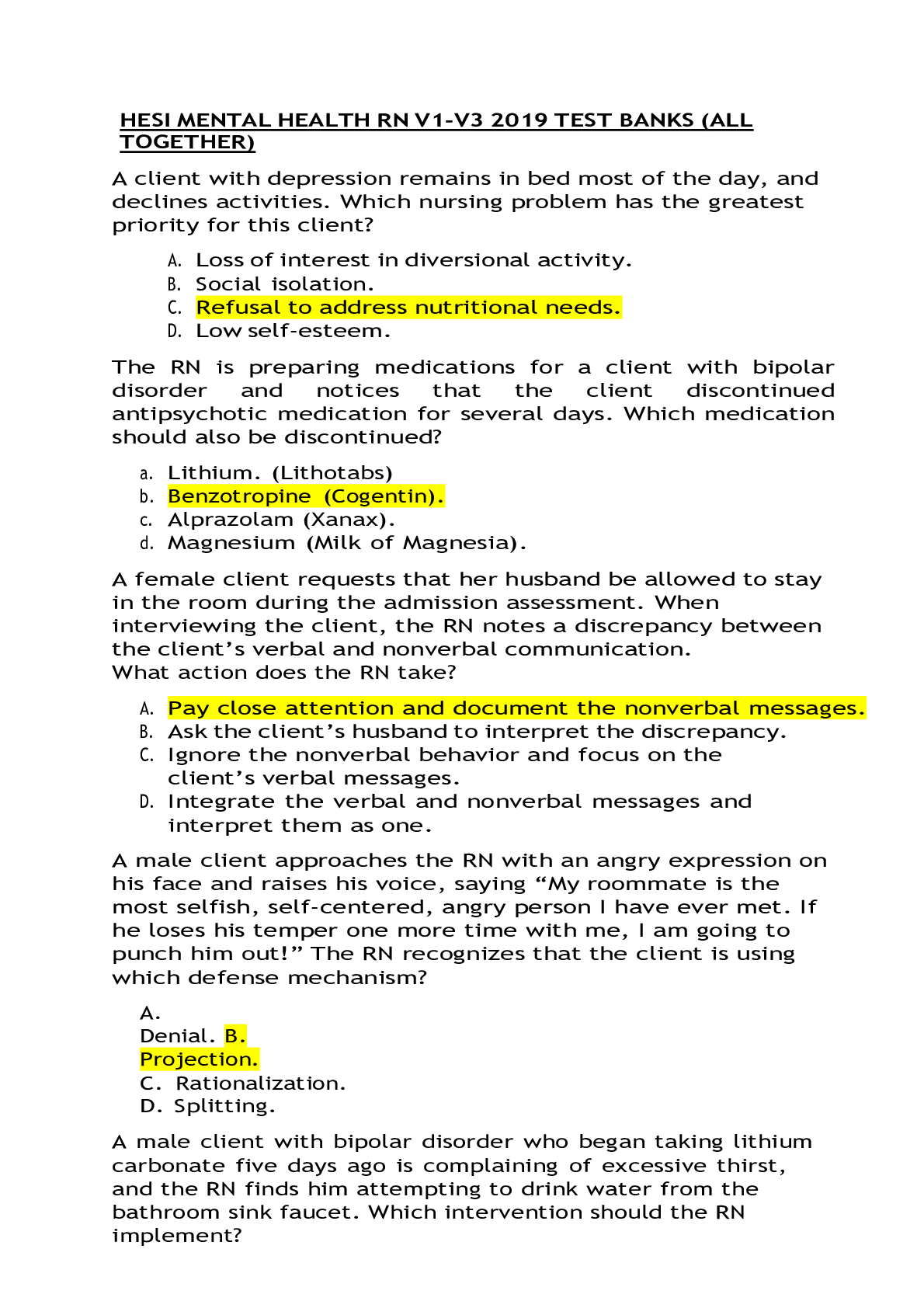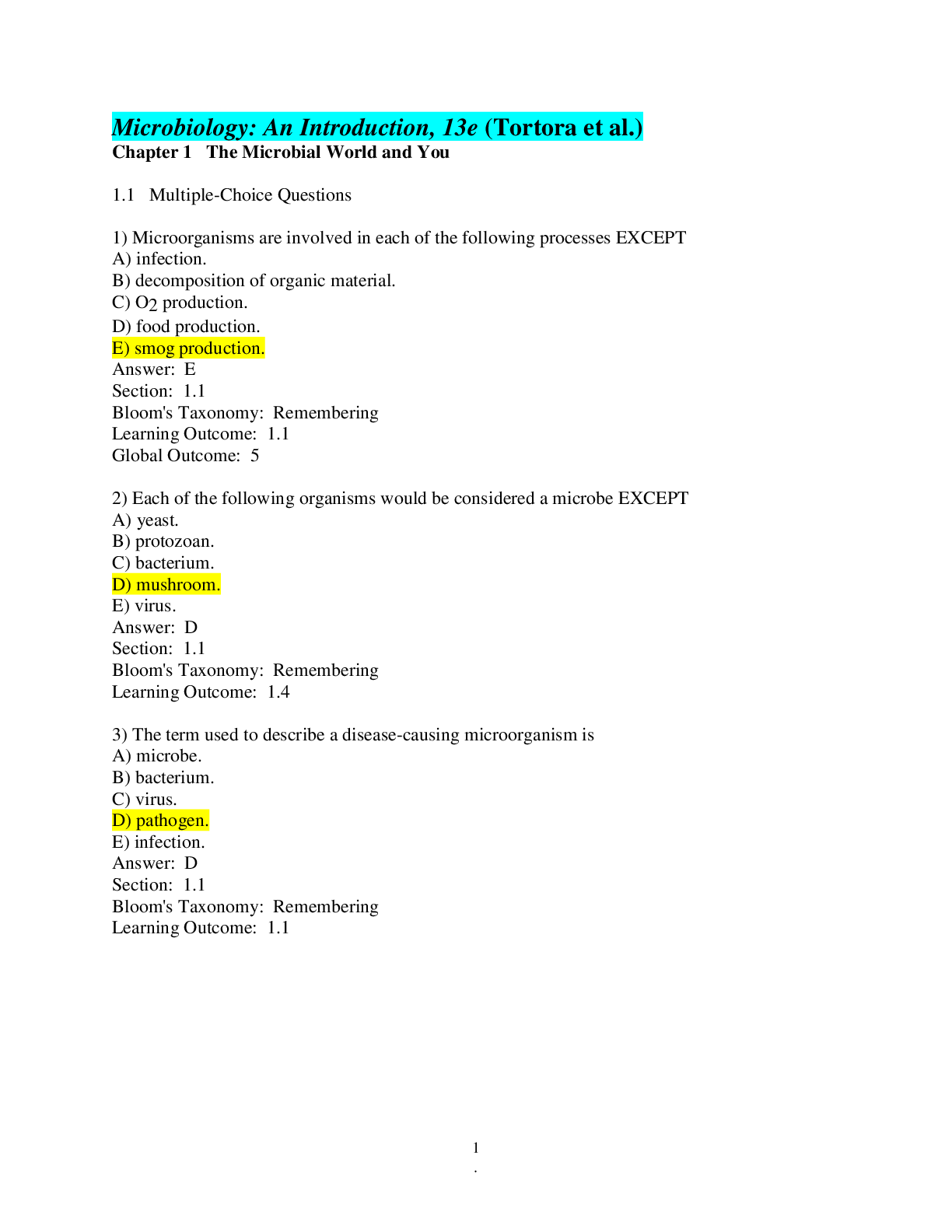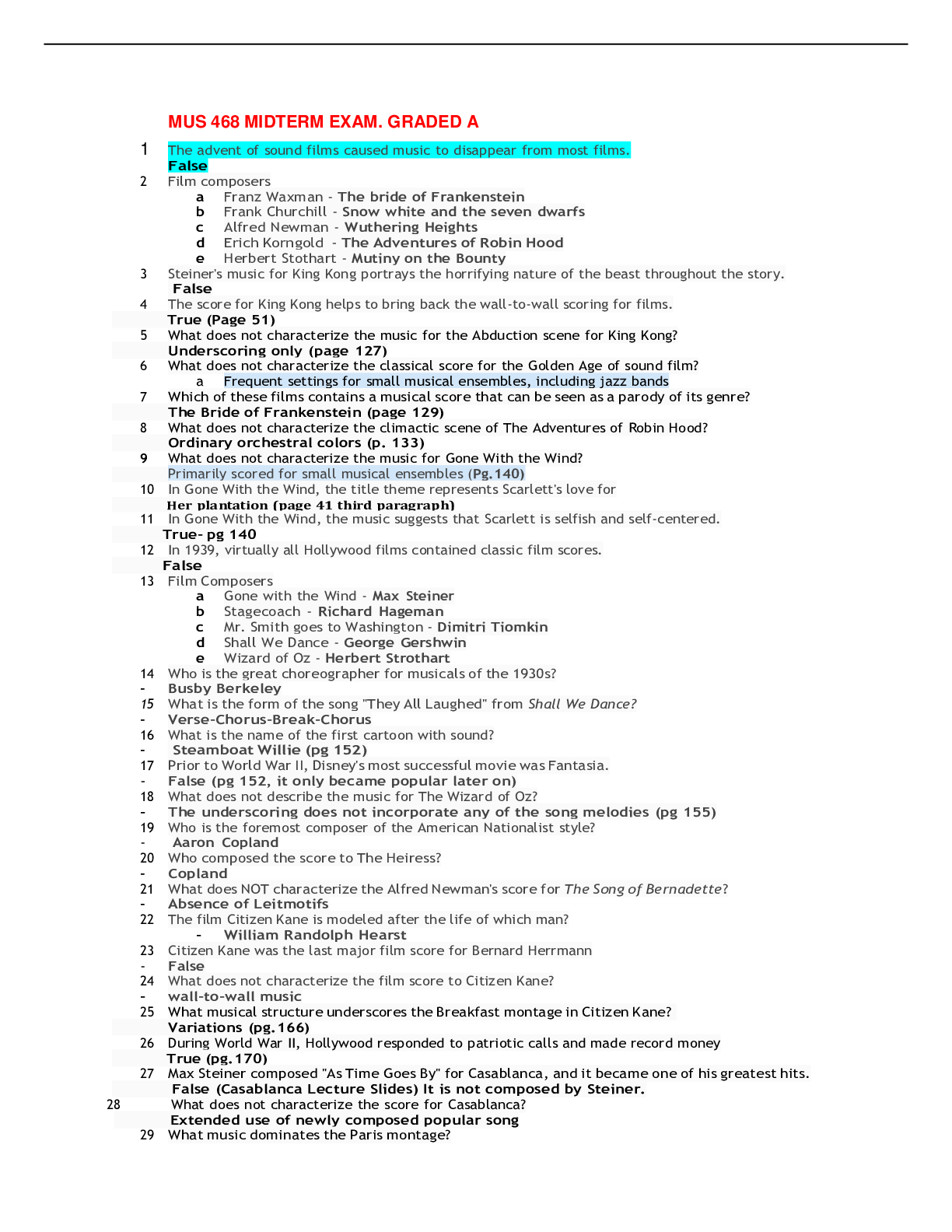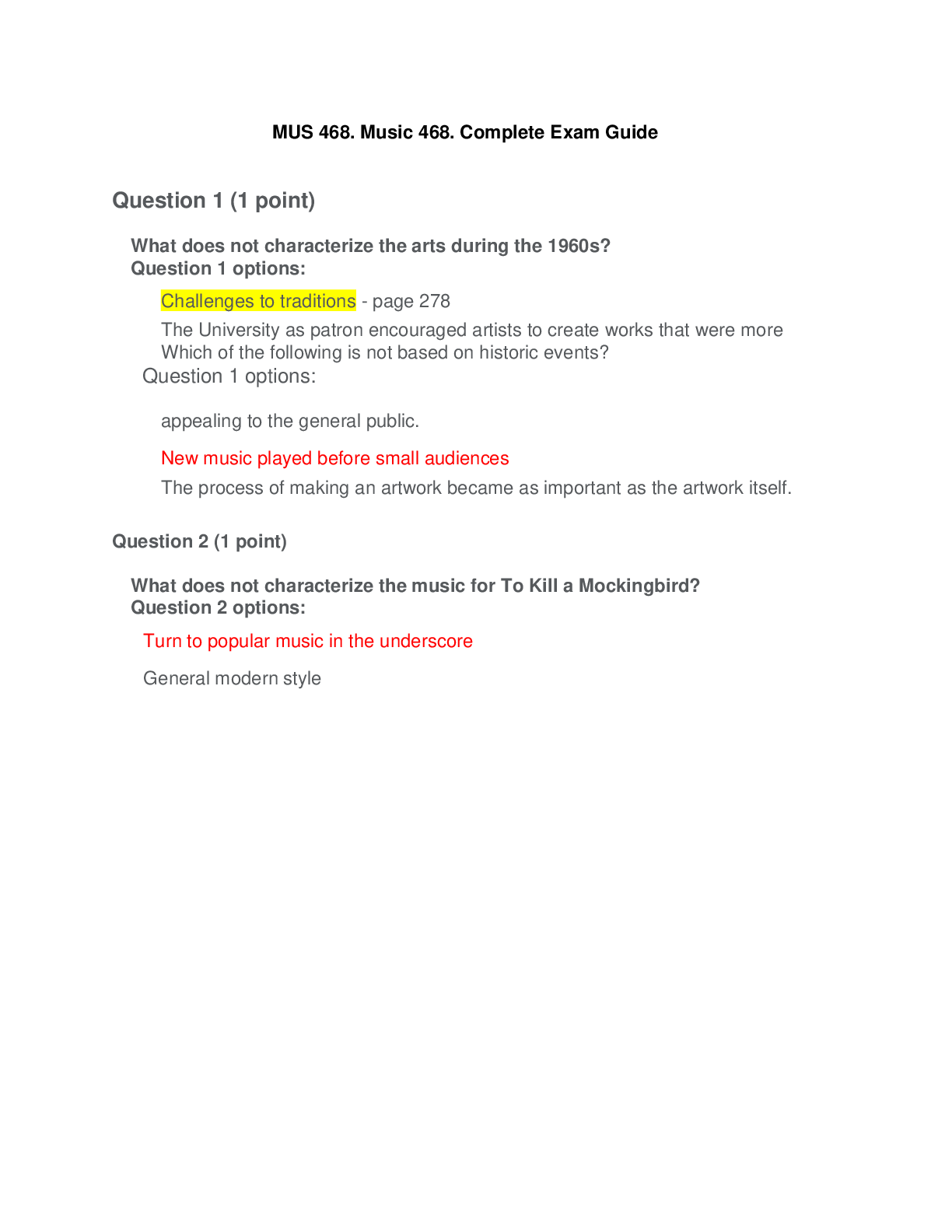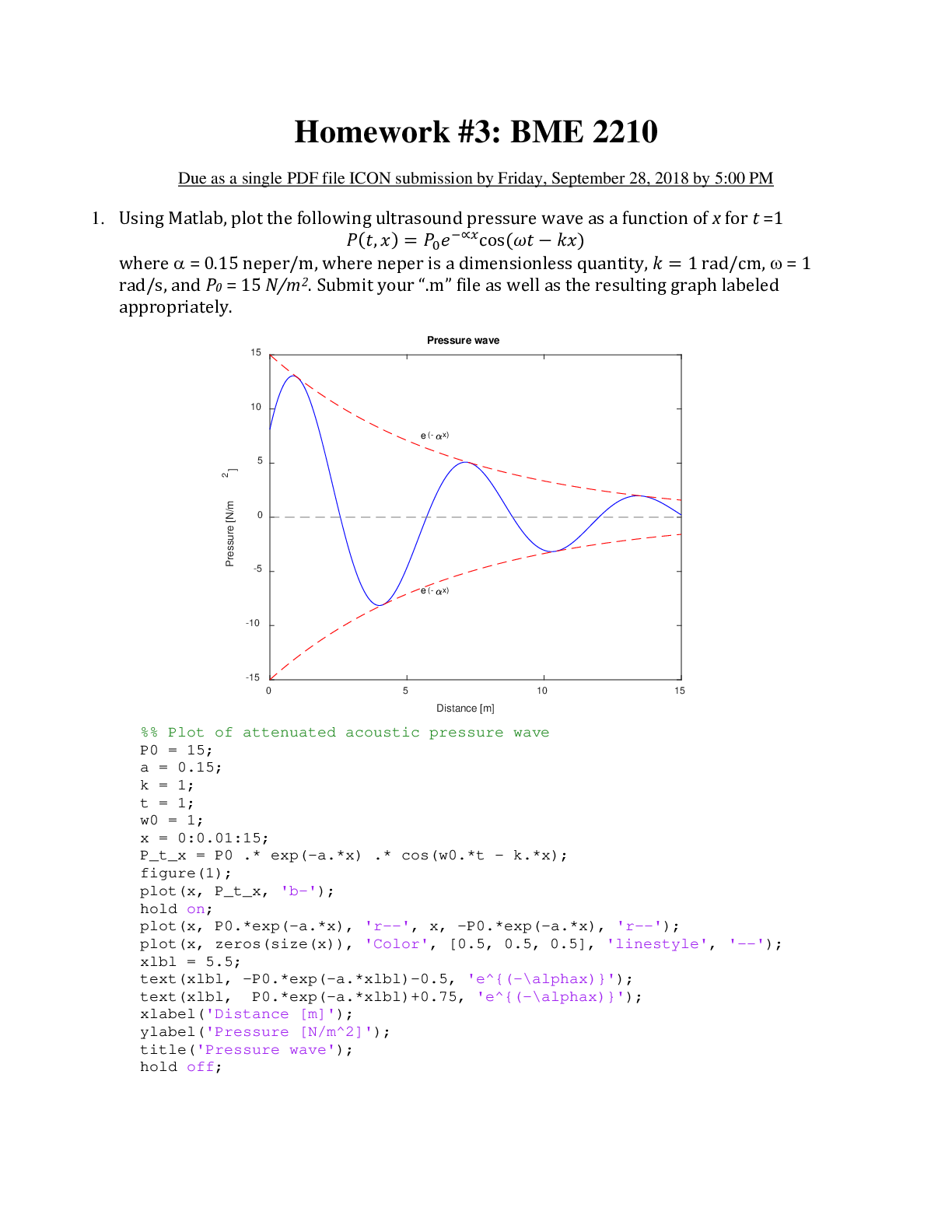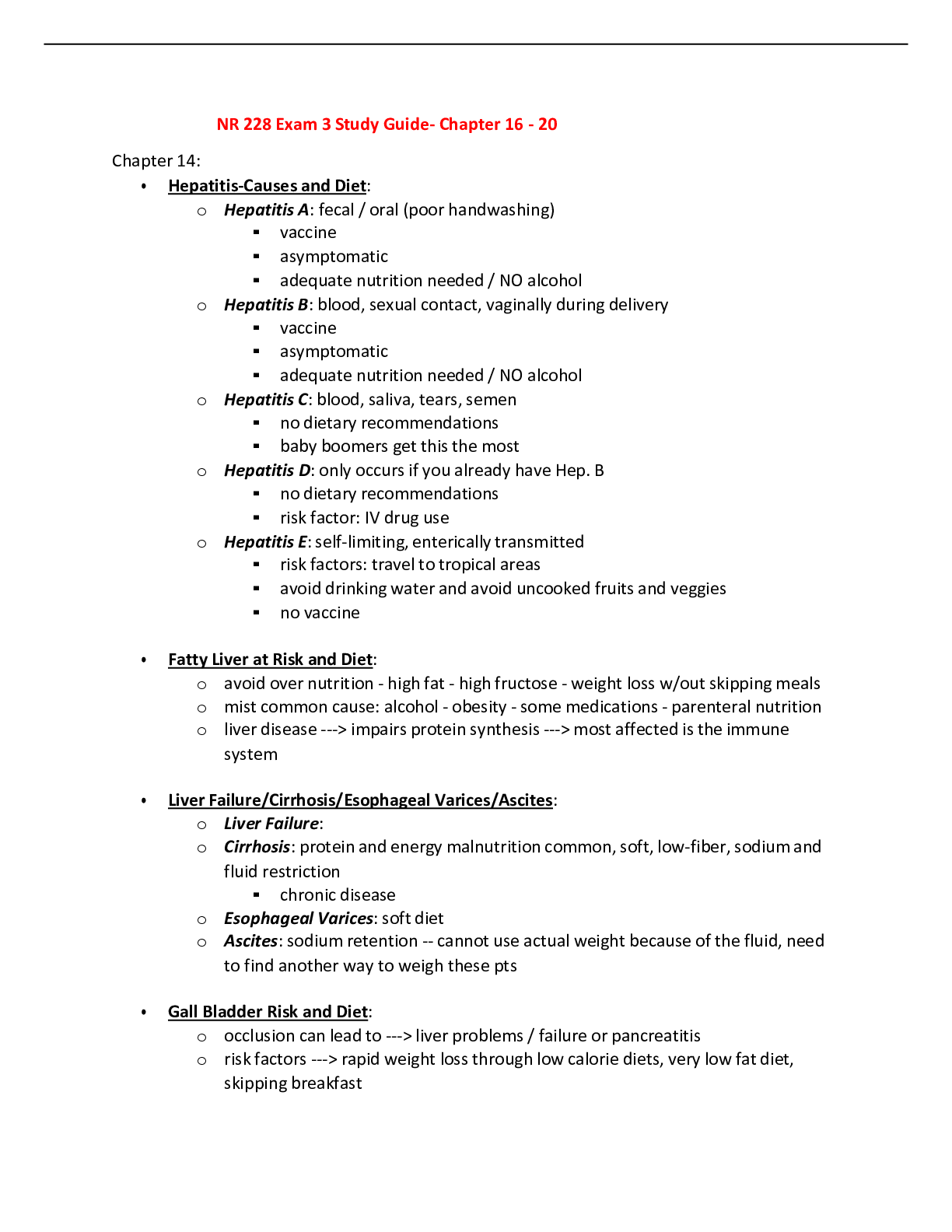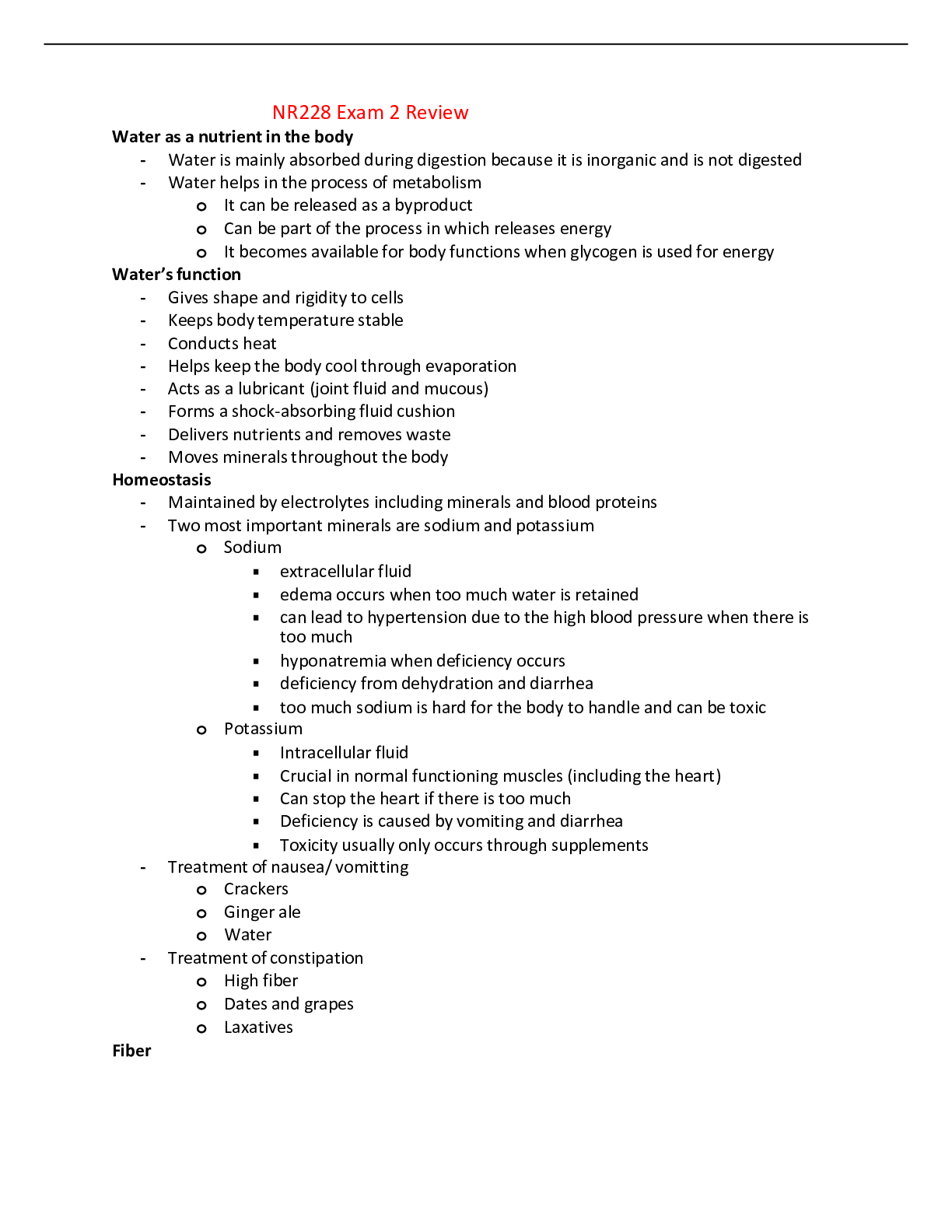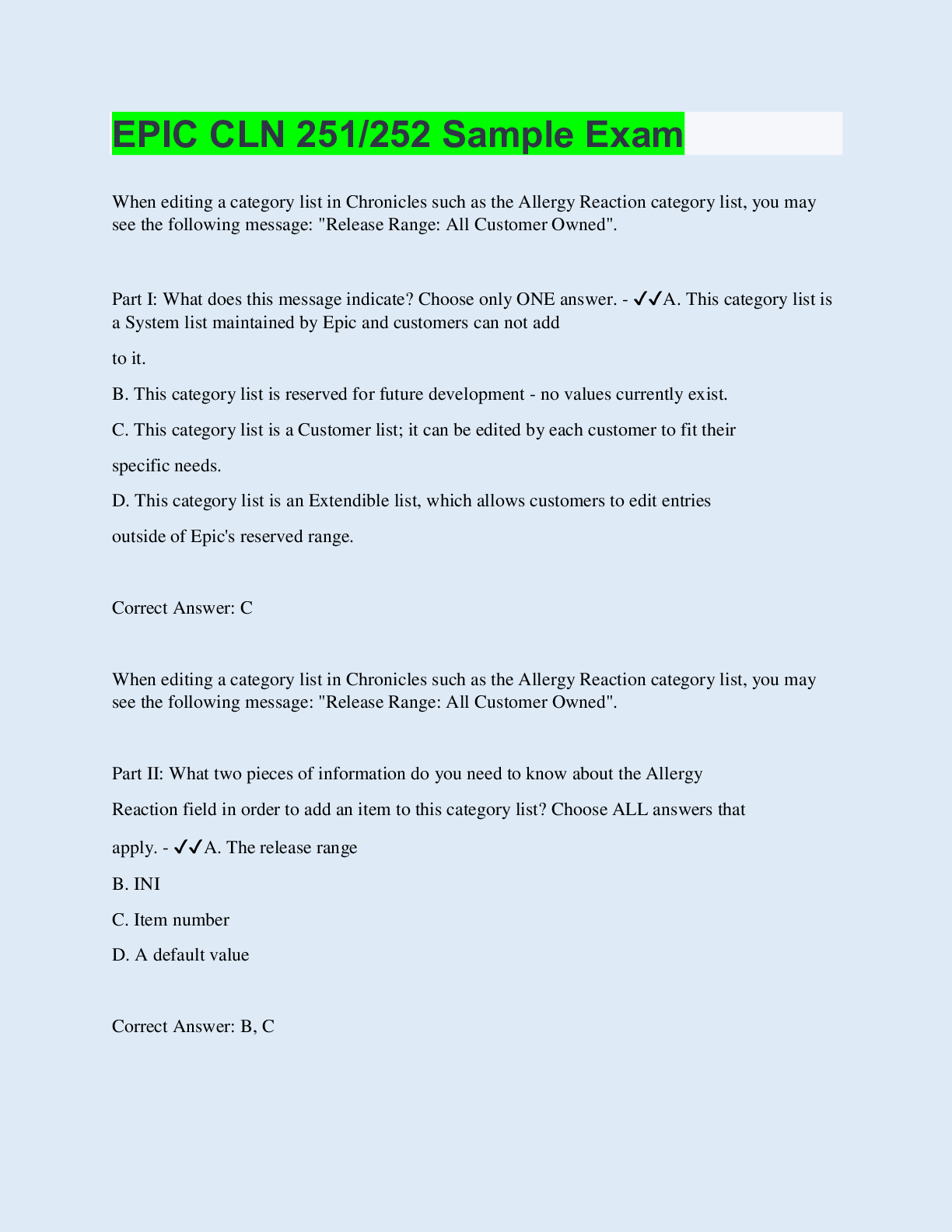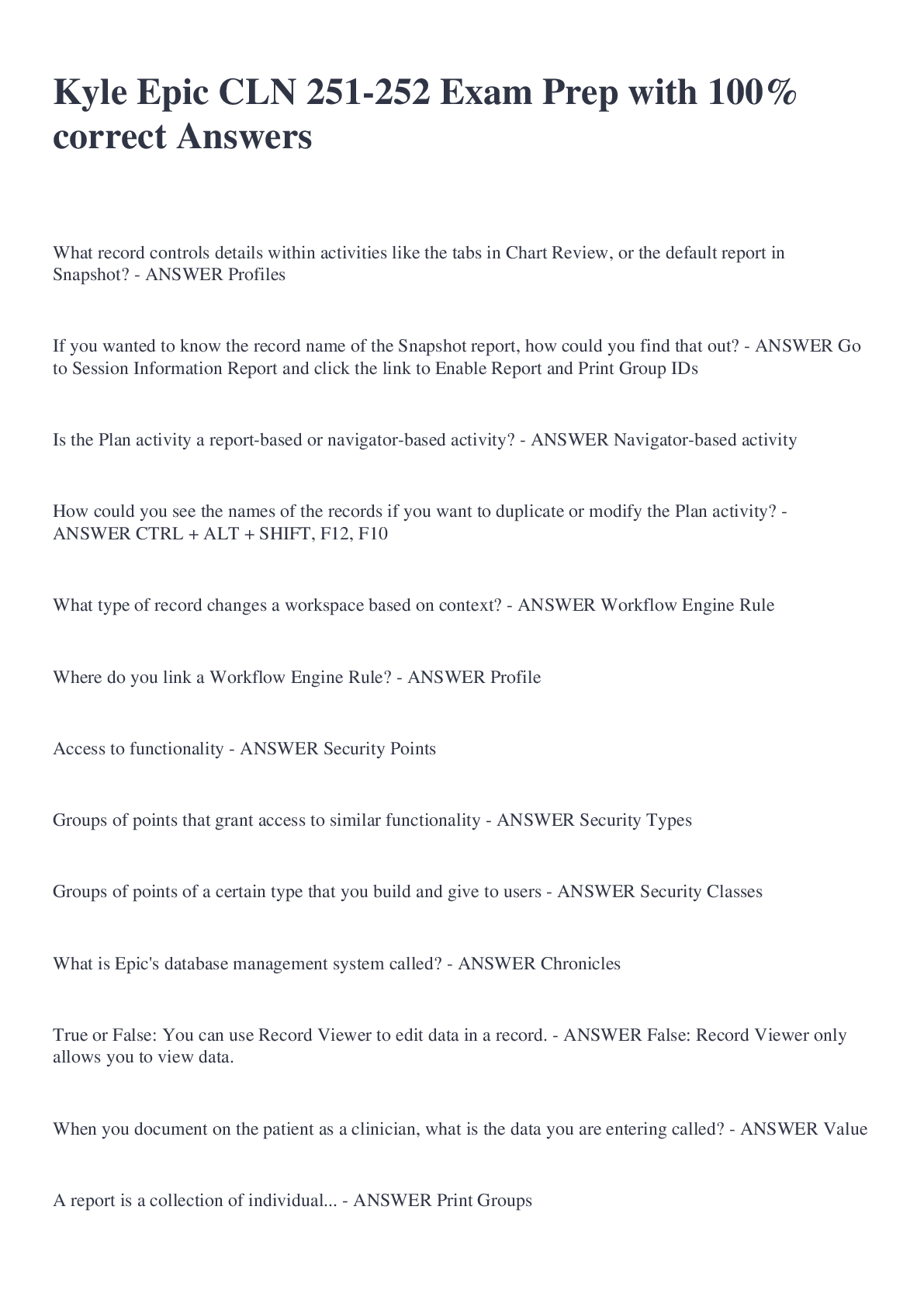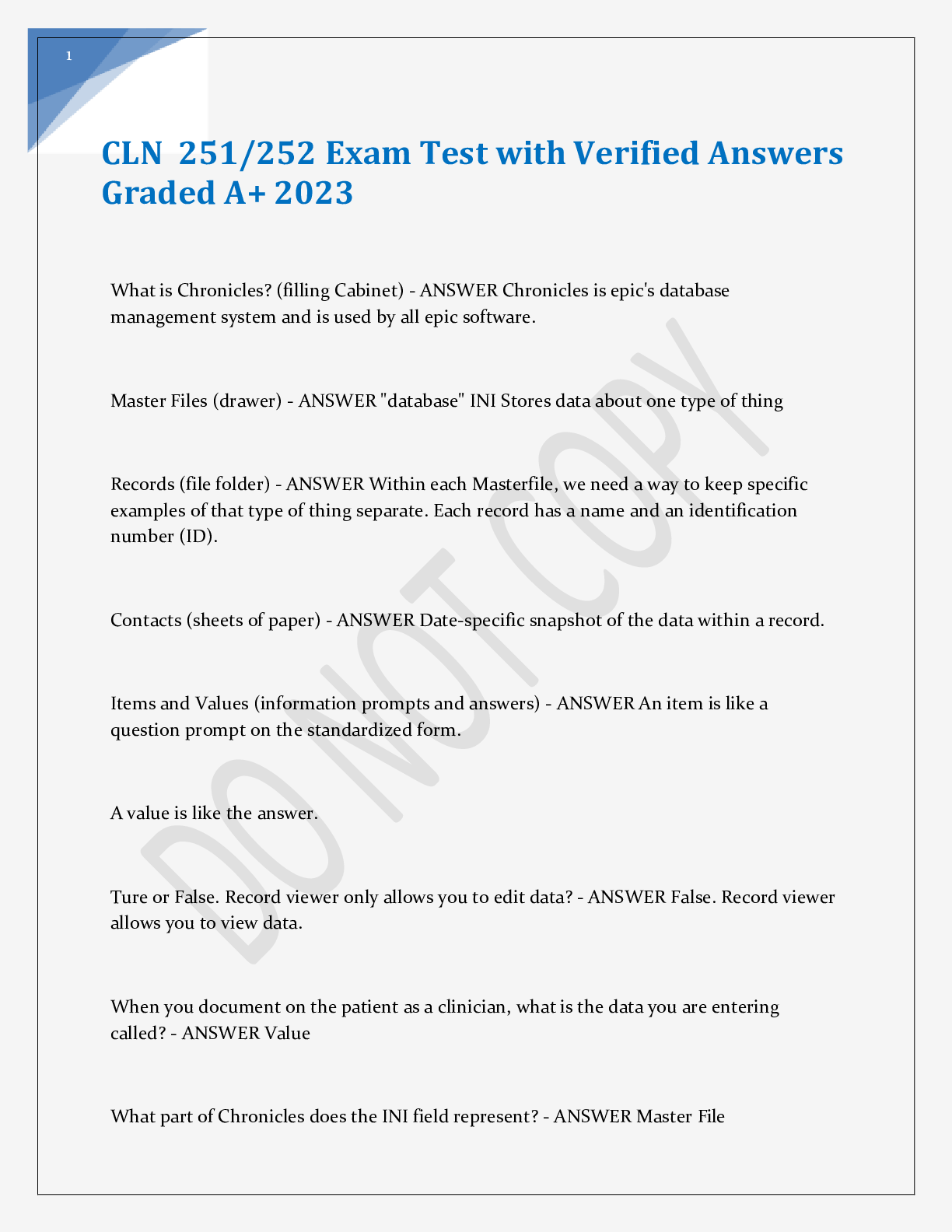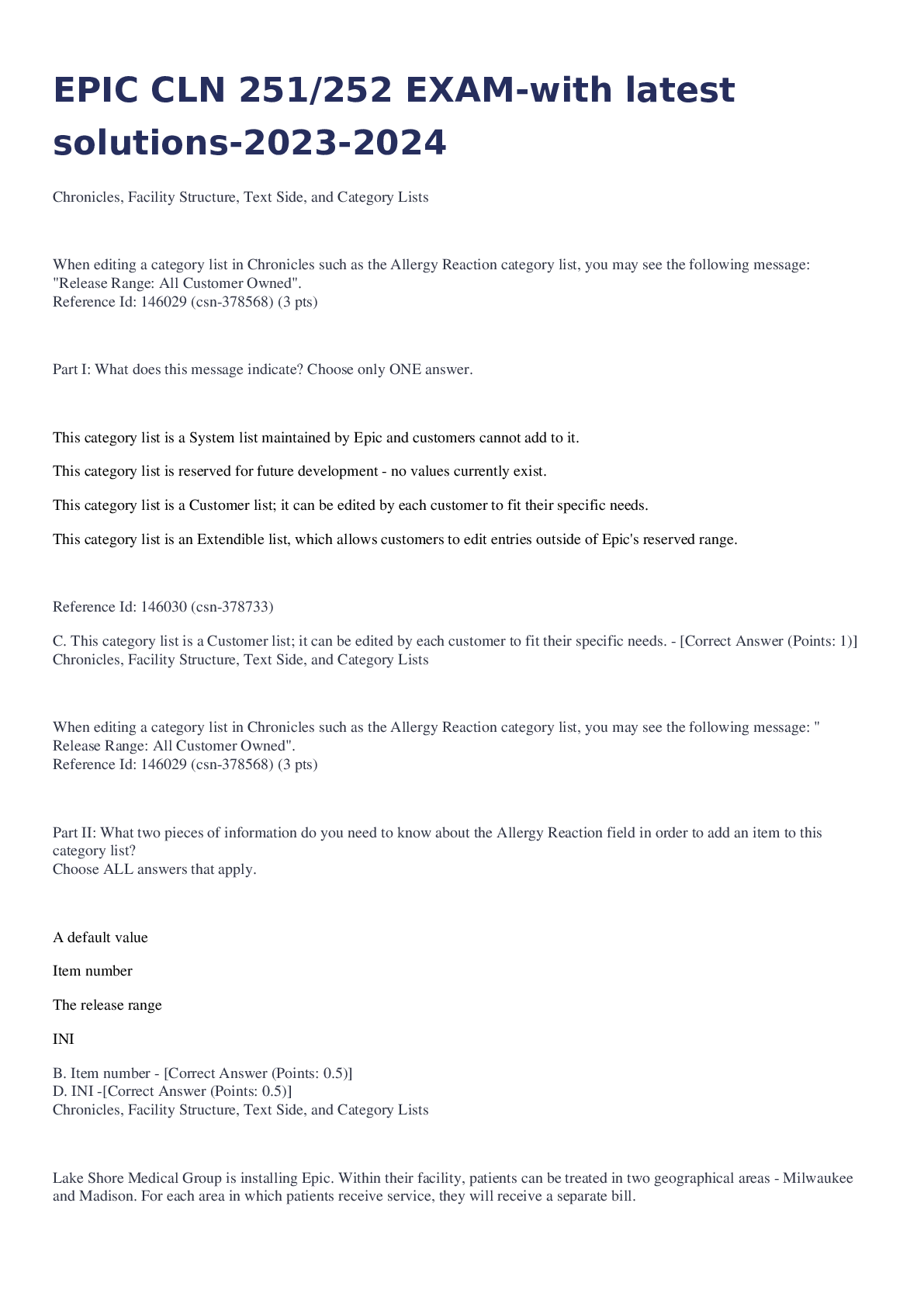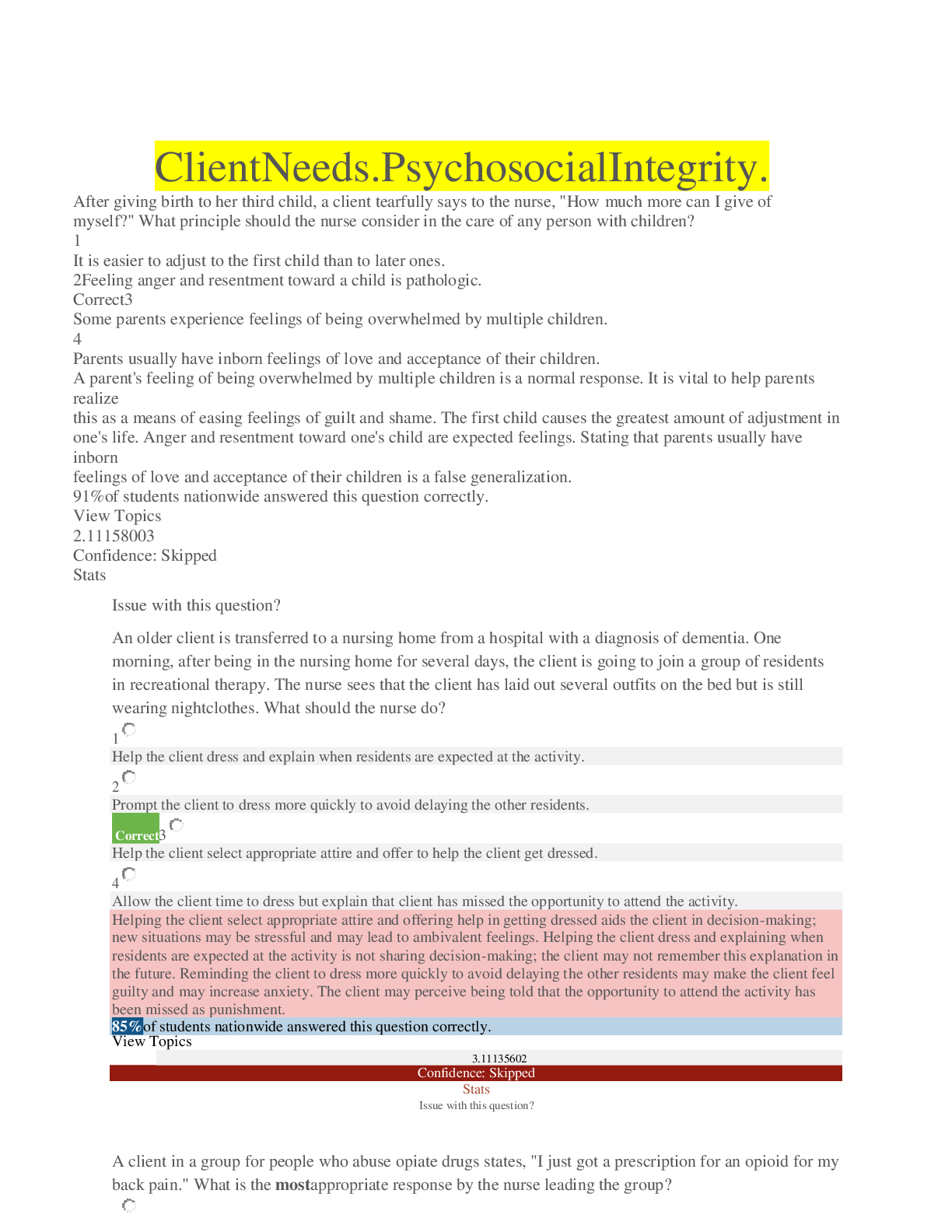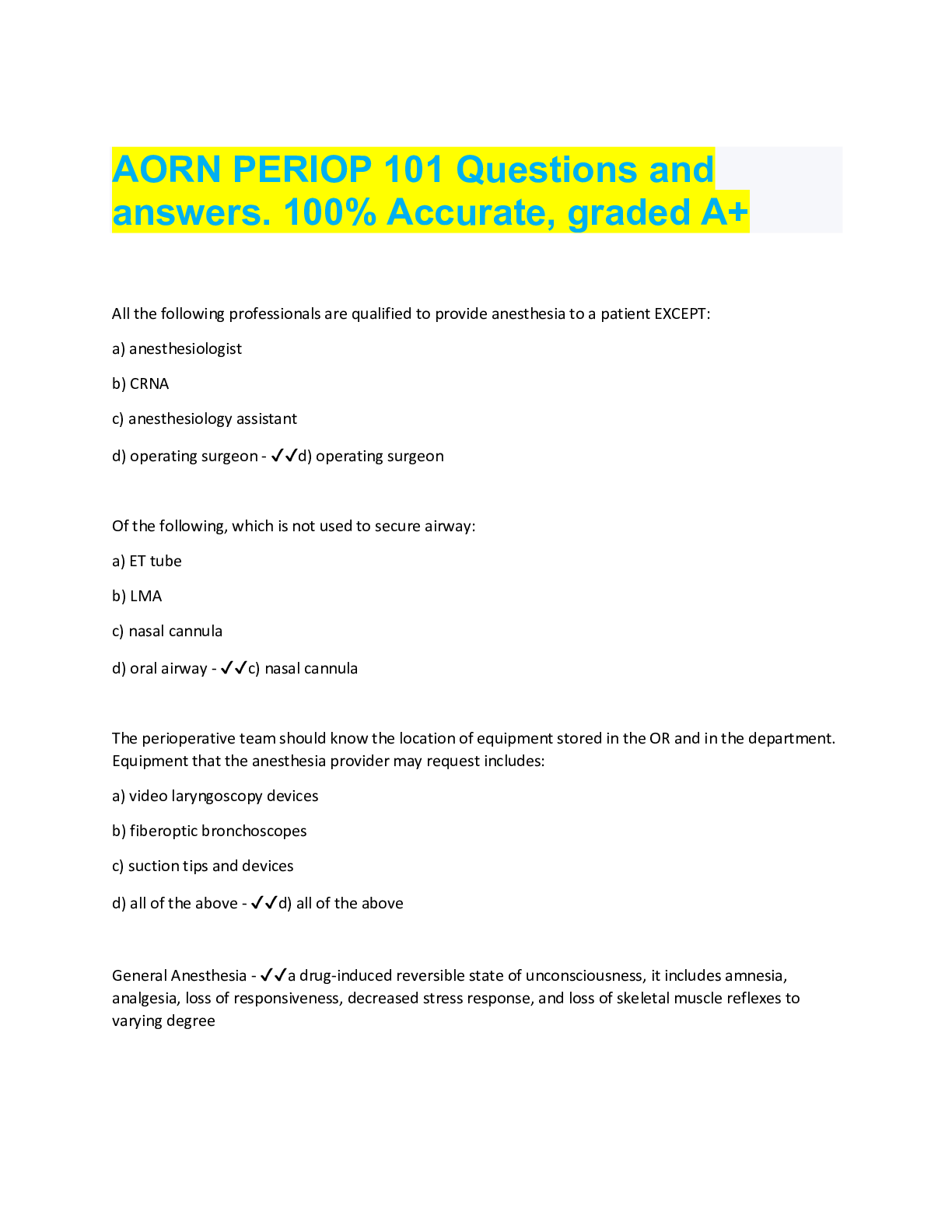611-PATHO EXAM 2 INTENSE Q&A- GRADED 100%
Document Content and Description Below
611-PATHO EXAM 2 INTENSE Q&A- GRADED 100% 1. Review: the parasympathetic system is all about what? 2. The sympathetic nervous system primarily serves to protect an individual by doing which of th... e following? (select all that apply) A. Decreasing mucous production B. Increasing blood sugar levels C. Increasing body temperature D. Decreasing sweat excretion E. Increasing blood pressure In general, sympathetic stimulation promotes responses that are concerned with the protection of the individual, which include increasing glucose, body temp, and BP. 3. Review: the sympathetic system is all about what? 4. Which characteristic is the most critical index of nervous system dysfunction? LOC is the most critical clinical index of nervous system function or dysfunction. An alteration in consciousness indicates either improvement or deterioration of a person’s condition. 5. Thought and goal-oriented behaviors are functions of which area of the brain? The prefrontal area is responsible for goal-oriented behavior such as the ability to concentrate, short-term or recall memory, and the elaboration of thought and inhibition on the limbic (emotional) areas of the CNS. 6. Where is the region responsible for the motor aspects? Broca speech area is the only region responsible for the motor aspects of speech. 7. Parkinson and Huntington diseases are associated with defects in which area of the brain? 8. Maintenance of a constant internal environment and the implementation of behavioral patterns are main functions of which area of the brain? Hypothalamic function falls into 2 major areas: 1) maintenance of a constant internal environment, and 2) implementation of behavioral patterns. 9. What parts of the brain mediate the expression of affect, both emotional and behavioral states? 10. Reflex activities concerned with heart rate, blood pressure, respirations, sneezing, swallowing, and coughing are controlled by which area of the brain? The medulla oblongata makes up the myelencephalon and is the lowest portion of the brainstem. 11. Which area of the brain assumes the responsibility for conscious and unconscious muscle synergy and for maintaining balance and posture? 12. The brain receives approximately what percentage of the cardiac output? 13. What evidence does the nurse expect to see when a patient experiences trauma to the hypothalamus? (select all that apply) A. Uneven expression of mood B. Unstable blood glucose levels C. Poor regulation of body temperature D. Visual disturbances such as blurred vision E. N/V and symptoms of gastroesophageal reflux disease The hypothalamus forms the base of the diencephalon. Hypothalamic function controls autonomic nervous system function, regulation of body temp, endocrine function (glucose levels), and regulation of emotional expression. 14. What is the first defense of our bodies? 15. Which action is the purpose of the inflammatory process? If the epithelial barrier is damaged, then a highly efficient local and system response (inflammation) is mobilized to limit the extent of damage, to protect against infection, and to initiate the repair of damaged tissue. 16. What are the 4 cardinal signs of infection? There is a 5th sign known as loss of function (functio laesa) but Dr. Wunderlich did not mention this. 17. Which type of white blood cell is first to arrive at the site of infection? 18. What causes the edema that occurs during the inflammatory process? The increased flow and capillary permeability result in a leakage of plasma from the vessels, causing swelling in the surrounding tissue and is solely responsible for inflammation-induced edema. 19. What process causes heat and redness to occur during the inflammatory process? The increased blood flow, as a result of vasodilation and increasing concentration of red cells at the site of inflammation cause locally increased warmth and redness. 20. The chemotactic factor affects the inflammatory process by? Two chemotactic factors, neutrophil chemotactic factor (NCF) and eosinophil chemotactic factor of anaphylaxis (ECF-A), are released during mast cell degranulation. NCF attracts neutrophils (a type of leukocytes), and ECF-A attracts eosinophils to the site of inflammation. 21. What is pain mediated by? 22. The function of opsonization related to the complement cascade is to: C3b adheres to the surface of a pathogenic microorganism and serves as an efficient opsonin. Opsonins are molecules that tag microorganisms for destruction by cells of the inflammatory system, primarily neutrophils and macrophages. 23. During phagocytosis what is occurring during the step referred to as opsonization? During phagocytosis, opsonization involes only the recognition and adherence of phagocytes to bacteria. 24. What is the correct sequence of phagocytosis? Once the phagocytic cell enters the inflammatory site, the only correct sequence of phagocytosis involves opsonization or recognition of the target and adherence of the phagocyte to it, engulfment, or ingestion or endocytosis, and the formation of phagosome, fusion with lysosomal granules within the phagocyte and destruction of the target. 25. Which manifestations of inflammation is systemic? The only primary systemic changes associated with the acute inflammatory response are fever, leukocytosis (a transient increase in circulating leukocytes), and increased levels in circulating plasma proteins. 26. The acute inflammatory response is characterized by fever that is produced by the hypothalamus being affected by? Fever-causing cytokines are known as endogenous pyrogens. 27. When considering white blood cell differentials, acute inflammatory reactions are related to elevations of which leukocyte? A. Monocytes B. Eosinophils C. Neutrophils D. Basophils Only neutrophils are the predominant phagocytes in the early inflammatory site, arriving within 6-12 hours after the initial injury, they ingest (phagocytose) bacteria, dead cells, and cellular debris at the inflammatory site. 28. What occurs during the process of repair after tissue damage? Repair is the replacement of destroyed tissue with scar tissue. Scar tissue is primarily made up of collagen, which fills in the lesion and restores tensile strength but cannot carry out the physiologic functions of the destroyed tissue. 29. When cellular damage occurs and regeneration is minor with no significant complications, the process of returning the cells to pre-injury function is referred to as: If damage is minor with no complications and destroyed tissues are capable of regeneration, then returning the injured tissues to an approximation of their original structure and physiologic function is possible. This restoration is called resolution. 30. The role of fibroblasts during the reconstructive phase of wound healing is to? Fibroblasts are the most important cells during the reconstructive phase of wound healing because they synthesize and secrete collagen and other connective tissue proteins. Macrophage-derived transforming growth factor-beta (TGF-Beta) stimulates fibroblasts. 31. Some older adults have impaired inflammation and wound healing because of which problems? In some cases, impaired healing is not directly associated with aging, in general, but can instead be linked to a chronic illness such as cardiovascular disease or diabetes mellitus. 32. Which cell is the body’s primary defense against parasite invasion? Eosinophils serve as the body’s primary defense against parasites. 33. Normal bacterial flora found in the intestines produce vitamin K to assist in the absorption of which of the following? (select all that apply) • Calcium • Fatty acids • Large polysaccharides • Iron • Magnesium The flora’s production of vitamin K is needed to absorb various ions, such as calcium, iron, and magnesium. 34. An individual’s acquired-immunity is dependent on the function of which cells? (select all that apply) • T lymphocytes • B lymphocytes • Macrophages • Opsonins • Neutrophils These cells along with dendritic cells are involved in acquired-immunity. 35. Which type of immunity is produced by an individual after either natural exposure to the antigen or after immunization against the antigen? An individual produces active-acquired immunity (active immunity) after natural exposure to an antigen or after immunization, whereas passive-acquired immunity (passive immunity) does not involve the host’s immune response at all. The innate immune system, also known as nonspecific immune system and the first line of defense, is composed of the cells and mechanisms that defend the host from infection by other organisms in a nonspecific manner, which means that the cells of the innate system recognize and respond to pathogens in a generic way 36. What is the role of a natural killer (NK) cells? The main function of NK cells is to recognize and eliminate cells infected with viruses, although they are also somewhat effective at eliminating other abnormal host cells, specifically cancer cells. 37. What type of immunity is produced when an immunoglobulin crosses the placenta? Passive-acquired immunity (passive immunity) does not involve the host’s immune response at all. Rather, passive immunity occurs when preformed antibodies or T lymphocytes are transferred from a donor to the recipient. This transfer can occur naturally, as in the passage of maternal antibodies across the placenta to the fetus, or artificially, as in a clinic using immunotherapy for a specific disease. 38. When antigens are administered to produce immunity, why are different routes of administration considered? Each route preferentially stimulates a different set of lymphocyte-containing (lymphoid) tissues and therefore results in the induction of different types of cell-mediated or humoral immune responses. 39. Which immunoglobulin is present in blood, saliva, breast milk, and respiratory secretions? IgA can be divided into two subclasses, IgA1 and IgA2. IgA1 molecules are predominately found in the blood, whereas IgA2 is the predominant class of antibody found in normal body secretions. 40. Which antibody initially indicates a typical primary immune response? Typically, IgM is produced first (primary immune response), followed by IgG against the same antigen. 41. An individual is more susceptible to infections of mucous membranes when he or she has a seriously low level of which immunoglobulin antibody? The IgA molecules found in bodily secretions are dimers anchored together through a J- chain and secretory piece. This secretory piece is attached to the IgA antibodies inside the mucosal epithelial cells and may function to protect these immunoglobulin antibodies against degradation by enzymes also found in the secretions, thus decreasing the risk of infections in the mucous membrane. 42. Which is an example of an endogenous antigen? 43. When a person is exposed to most antigens, antibodies can be usually detected in his or her circulation within? After only approximately 5-7 days is an IgM antibody specific for that antigen detected in the circulation. 44. Vaccinations are able to provide protection against certain microorganisms because of the? IgG production is considerably increased, making it the predominant antibody class of the secondary response. IgG is often present in concentrations several times larger than those of IgM, and levels of circulating IgG specific for that antigen may remain elevated for an extended period of time. 45. How does the aging process of the T-cell activity affect older adults? T-cell activity is deficient in older adults, and a shift in the balance of T-cell subsets is observed. These changes may result in increased susceptibility to infection. 46. A hypersensitivity reaction that produces an allergic response is called? Anaphylaxis Examples of systemic anaphylaxis are allergic reactions to bee stings, peanuts, and fish. 47. The common hay fever allergy is expressed through a reaction that is mediate by which class of immunoglobins? IgE Type I reactions are mediated by antigen-specific IgE and the products of tissue mast cells. The most common allergies (pollen allergies) are type I reactions. In addition, most type I reactions occur against environmental antigens and are therefore allergic. 48. Which type of antibody is involved in type I hypersensitivity reaction? IgE 49. Blood transfusion reactions are an example of? Alloimmunity Only alloimmunity (also termed isoimmunity) occurs when the immune system of one individual produces an immunologic reaction against tissues of another individual. 50. What is the mechanism that results in type II hypersensitivity reactions? Antibodies bind to the antigens on the cell surface The mechanism that results in a type II hypersensitivity reaction begins with antibody binding to tissue-specific antigens or antigens that have attached to particular tissues. The cell can be destroyed by antibody IgG or IgM and activation of the complement cascade through the classical pathway. 51. When mismatched blood is administered causing an ABO incompatibility the erythrocytes are destroyed by? Complement-mediated cell lysis Erythrocytes are destroyed by complement-mediated lysis in individuals with automimmune hemolytic anemia or as a result of an alloimmune reaction to ABO mismatched transfused blood cells. 52. When antibodies are formed against red blood cell antigens of the Rh system, the blood cells are destroyed by? Phagocytosis in the spleen Antibodies against platelet-specific antigens or against red blood cell antigens of the Rh system coat those cells at low density, resulting in their preferential removal by phagocytosis in the spleen, rather than by complement-mediated lysis. 53. How are target cells destroyed in a type II hypersensitivity reaction? Natural killer cells The mechanism that results in a type II hypersensitivity reaction involves a subpopulation of cytotoxic cells that are not antigen specific (natural killer [NK] cells). Antibody on the target cell is recognized by Fc receptors on the NK cells, which releases toxic substances that destroy the target cell. 54. Graves disease (hyperthyroidism) is an example of which type II hypersensitivity reaction? Modulation 55. Graves disease is a result of? Autoantibodies binding to thyroid-stimulating hormone (TSH)-receptor sites 56. Type III hypersensitivity reactions are a result of which action? Antibodies binding to soluble antigens that were released into body fluids and the immune complexes being deposited in the tissues. Antigen-antibody (immune) complexes that are formed in the circulation and then deposited later in vessel walls or extravascular tissues cause most type III hypersensitivity diseases. 57. Reyaud phenomenon is an example of which type of hypersensitivity? Type III Raynaud phenomenon is a condition caused by the temperature-dependent deposition of immune complexes in the capillary beds of the peripheral circulation. 58. A person with type O blood is considered to be the universal blood donor because type O blood contains which of the following? • No antigens • Both A and B antigens • No antibodies • Both A and B antibodies No Antigens Because individuals with type O blood lack both types of antigens, they are considered universal donors, meaning that anyone can accept their red blood cells. Type O individuals, who have neither A or B antigen but have both anti-A and anti-B antibodies cannot accept blood from any of the other three blood types. 59. Immunoglobulin E (IgE) is associated with which type of hypersensitivity? Type I Hypersensitivity reactions have been divided into four distinct types: type I (IgE- mediated; beesting, peanuts, fish ) hypersensitivity reactions, type II (tissue-specific; mismatched blood transfusion, Graves disease) hypersensitivity reactions, type III (immune complex-mediated; Raynauld disease) hypersensitivity reactions, and type IV (cell-mediated; graft rejection) hypersensitivity reactions. 60. Some clinical examples of type IV hypersensitivity reactions include (select all that apply): • Graft rejection • Allergic reactions • Autoimmune reactions • Delayed Graft rejection, allergic reaction, and delayed 61. Which disorders are considered autoimmune? (select all that apply): • Crohn disease • Addison disease • Systemic lupus erythematosus • Non-insulin dependent diabetes • Rheumatoid arthritis Crohn’s disease, Addison disease, systemic lupus erythematosus, and rheumatoid arthritis 62. Patients with Lupus can suffer from? Facial rash (butterfly), photosensitivity, neurological, renal, and hematological disorders 63. Immunodeficiency disorders are differentiated into primary verses secondary. Primary is rare. What factors can contribute to immunodeficiency disorders? Aging (decrease ability to fight infections), psychological issues (emotional trauma), poor diet, metabolic diseases, genetic syndromes, radiation, some medical treatments (anesthesia, splenectomy), and chemotherapy. 64. What is the first stage in the infectious process? Colonization From the perspective of the microorganisms that cause disease, the infectious process undergoes four separate stages of progression: 1) colonization, 2) invasion, 3) multiplication, and 4) spread. 65. Which type of microorganism reproduces on the skin? Bacteria and fungi Only bacteria and fungi have the capacity to reproduce on the skin. 66. Which statement is true concerning exotoxins? • Exotoxins are contained in cell walls of gram-negative bacteria • Exotoxins are released during the lysis of bacteria • Exotoxins are released during bacterial growth • Exotoxins are able to initiate the complement and coagulation cascades Exotoxins are released during bacterial growth 67. Which statement is true about vaccines? • Most bacterial vaccines contain attenuated organisms • Vaccines require booster injections to maintain life-long protection • Most viral vaccines are made by using dead organisms • Vaccines provide effective protection against most infections Vaccines require booster injections to maintain life-long protection In general, vaccine-induced protection does not persist as long as infection-induced immunity, thus booster injections may be necessary to maintain protection throughout life. 68. Definition of toxigenicity An important factor in determining a pathogen’s ability to produce disease Toxigenicity is the ability of a pathogen to produce soluble toxins or endotoxins, which are factors that greatly influence the pathogen’s degree of virulence. 69. The infectious process is made up of invasion verses evasion. Evasion is when? The body’s defenses such as the inflammatory process is exhausted. Evasion is when those body defenses results in microorganisms being transported through the blood such as septicemia. 70. Cytokines are thought to cause fevers by stimulating the synthesis of which chemical mediator? Prostaglandin Cytokines seem to raise the thermoregulatory set point through stimulation of prostaglandin synthesis and turnover in thermoregulatory (brain) and non- thermoregulatory (peripheral) tissues. 71. Exotoxins, those are actually released during bacterial growth, they are _immunogenic_ so that’s good, so they are going to illicit this response. 72. Which statements are true regarding endotoxins? (select all that apply): • Endotoxins are lipopolysaccharides • Endotoxins are located in the walls of bacteria • Endotoxins are created during the process of lysis • Endotoxins are found in gram-negative microorganisms • Endotoxins are released during the destruction of its host Endotoxins are lipopolysaccharides, located in walls of bacteria, gram-negative, and are released during the destruction of the host. 73. Endotoxins if left unchecked can cause what? Disseminated intravascular coagulation (DIC) 74. Endotoxins work by? Causing incredible vasodilation 75. The CDC defines a diagnosis of AIDS is measured by a CD4 count less than _200 cells per microliter. 76. Which secretion transmits HIV? (select all that apply): • Semen • Urine • Saliva • Breast milk • Sweat HIV is a blood-borne pathogen present in body fluids such as blood, vaginal fluid, semen, and breast milk. 77. Exhaustion occurs if stress continues when which stage of the general adaptation syndrome is not successful? Adaptation This lack of adaptation ultimately causes impairment of the immune response, heart failure, and kidney failure, leading to death. 78. Which hormone prompts increased anxiety, vigilance, and arousal during a stress response? Norepinephrine Only the release of norepinephrine promotes arousal, increased vigilance, increased anxiety, and other protective emotional responses. 79. What is the effect that low-serum albumin has on the central stress response? Impaired circulation of epinephrine and norepinephrine Low-serum albumin impairs circulation of both epinephrine and norepinephrine since both bind to plasma protein albumin. 80. Stress-age syndrome directly results in depressed function of which system? Immune system-we just discussed this 81. Stress-induced norepinephrine results in? Peripheral vasoconstriction During stress, norepinephrine raises blood pressure by constricting peripheral vessels; it dilates the pupils of the eye, causes piloerection, and increases sweat gland action in the armpits and palms. 82. The most influential factor in whether a person will experience a stress reaction is his or her? Ability to cope In other words, a person does not have a stress reaction unless the stress exceeds his or her coping abilities. 83. What constricts peripheral vessels to increase blood pressure Norepinephrine 84. What increases gastric secretions? Cortisol-think of that ulcer we are all working on, increased stress leads to increased cortisol, increased gastic acid and bam-you got an ulcer!! 85. What increases cardiac output by increasing heart rate and myocardial contractility? Epinephrine 86. Cortisol is an important player in the stress response. Cortisol _inhibits_ that initial inflammatory effect and it acts to _suppress the activity of those helper T cells. Cortisol also promotes resolution of healing. So in a nutshell, cortisol actually acts to _suppress_the activities of those cytotoxic T cells. 87. A reduction is an individual’s number of natural killer (NK) cells appears to correlate with an increased risk for the development of? Depression A meta-analysis of studies shows a relationship between depression and the reduction in lymphocyte proliferation and natural killer cell activity. 88. The increased production of proinflammatory cytokines is associated with which considerations? Elevated anxiety levels and age/gender Increased levels of proinflammatory cytokines has been shown to have a possible link between stress and immune function. 89. Which organ is stimulated during the alarm phase of the general adaptation syndrome (GAS)? Hypothalamus The alarm phase of the GAS begins when a stressor triggers the actions of the hypothalamus and the sympathetic nervous system. 90. What is the difference between benign and malignant? Benign=cell’s appearance is well differentiated and slow growing and typically avascular, growth is expansive (pushing on other structures and cells. Malignant=the cell is a mess because the cells have gone rogue! And they spread rapidly, invasive, vascular, and metastasizing. 91. Which ctyokines initiate the production of corticotropin-releasing hormone (CRH)? IL-1 and IL-6 Although a number of stress factors initiate the production of CRH, only high levels of IL- 1 and IL-6 initiate a response. 92. What is the most common route for distant metastasis? Blood and lymphatic vessels-the Autobaun for cancer cells! 93. Staging of cancer provides a framework to determine treatment. 94. Staging system of cancer is as follows (example of breast cancer): refer to Workbook pg. 55 ➢ T1=within the breast tissue ➢ T2=still within the breast tissue but getting larger ➢ T3=start of invasion, either skin or chest wall ➢ T4=metastasis to other organs 95. Node involvement means: ➢ N2=fixed nodes involved 96. What are tumor cell markers? Hormones, enzymes, antigens, and antibodies that are produced by cancer cells Tumor (biologic) markers are substances produced by both benign and malignant cells that are found either in or on the tumor cells or in the blood, spinal fluid, or urine. Tumor markers may include hormones, enzymes, genes, antigens, and antibodies. 97. The function of the tumor cell marker is to? Screen individuals at high risk for cancer Screening and identifying individuals at high risk for cancer are ways tumor markers can be used. Keep in mind these markers are not used to definitively diagnosis or treat cancer and are not useful in predicting specific sites of cancer development. 98. Autocrine stimulation is the ability of cancer cells to? Secrete growth factors that stimulate their own growth Cancer cells must have mutations that enable them to proliferate in the absence of external growth signals. To achieve this, some cancers acquire the ability to secrete growth factors that stimulate their own growth, a process known as autocrine stimulation. All I can say is cancer cells are smart little shits! 99. Which cancers are all associated with chronic inflammation? Colon, thyroid gland, and urinary bladder Some organs appear to be more susceptible to the oncogenic effects of chronic inflammation; for example, the GI tract, prostate, thyroid gland, pancreas, urinary bladder, pleura, and skin. One large study found a 66% increase in the risk of lung cancer among women with chronic asthma, an inflammatory disease of the airways. 100. Chronic inflammation causes cancer by? Releasing compounds such as reactive oxygen species that promote mutations Inflammatory cells release compounds such as reactive oxygen species (ROS) and other reactive molecules, that can promote mutations and block the cellular response to DNA damage. 101. Review your Workbook pg. 55. I need you to determine the extent of this cancer. It has been determined that a tumor is in stage 2. What is the meaning of this finding? Cancer is locally invasive Cancer confined to the organ of origin is stage 1; cancer that is locally invasive is stage 2; cancer that has spread to regional structures, such as the lymph nodes, is stage 3; and cancer that has spread to distant sites, such as a liver cancer spreading to the lung or a prostate cancer spreading to bone is stage 4. 102. Many cancers create a mutation of ras. Ras is a? Intracellular-signaling protein that regulates cell growth Up to 1/3 of all cancers have an activating mutation in the gene for an intracellular signaling protein called ras. This mutant ras stimulates cell growth even when growth factors are missing. 103. The ras gene converts from a proto-oncogene to an oncogene by? Altering one or more nucleotide base pairs A point mutation is the alteration of one or a few nucleotide base pairs. This type of mutation can have profound effects on the activity of proteins. A point mutation in the ras gene converts it from a regulated proto-oncogene to an unregulated oncogene, an accelerator of cellular proliferation. 104. How do cancer cells use the enzyme telomerase? To switch on the telomerase to enable cells to divide indefinitely Cancer cells, when they reach a critical age, somehow activate telomerase to restore and maintain their telomeres and thereby make it possible for cells to divide over and over again. 105. What is the role of vascular endothelial growth factor (VEGF) and basic fibroblast growth factor (bFGF) in cell metastasis? To develop new blood vessels to feed cancer cells By recruiting new vascular endothelial cells and initiating the proliferation of existing blood vessel cells, the angiogenic factors, such as VEGF and growth factor bFGF, allow small cancers to become large cancers. 106. What statement is true regarding pain and cancer? Pain is generally associated with late-stage cancer Pain is generally associated with the late stages of cancer. Pressure, obstruction, invasion of a structure sensitive to pain, stretching, tissue destruction, and inflammation can cause pain. Pain is not the initial symptom of cancer nor does it indication that the cancer has metastasized. 107. What statement is true concerning aging and the occurrence of cancer? Decline in immunologic functions, predisposition to nutritional inadequacies, and effects of immobility on the immune system Many common malignancies occur mostly in older age as a result of immunologic functions declining with age. Older persons are predisposed to nutritional inadequacies, and malnutrition impairs immunocompetence. Far-advanced cancer often results in immobility and general debility that worsens with age. No research supports a correlation between aging and a reluctance to seek health care, in general, or cancer screenings, in particular. 108. Paraneoplastic syndromes may be the first or most prominent manifestation of a _cancer_. Examples include; Cushing Syndrome (endocrine) mediated by humoral factors such as hormones or cytokines excreted by tumor cells or by an immune response. 109. What is the most commonly reported symptom of cancer treatment? Fatigue-duh! 110. The difference between focal and diffuse brain injury. Focal=is typically in one area such as a stroke, epidural hemorrhage or subdural hemorrhage. Diffuse=affects the entire brain such as hypoxia, meningitis, and encephalitis. Remember the brain is a very small vault. 111. In diabetes insipidus we watch for _increased intracranial pressure. 112. Pressure on the pituitary gland from ICP prevents _anti-diuretic hormone from being excreted which leads to _high_ output of urine. *Really got to watch that urine output because it will be really high! 113. What term is used to describe the complication that can result from a spinal cord injury above T6 that is producing paroxysmal hypertension, as well as piloerection and sweating above the spinal cord lesion? Autonomic hyperreflexia Individuals most likely to be affected have lesions at the T6 level or above. Paroxysmal hypertension (up to 300 mm Hg systolic), a pounding headache, blurred vision, sweating above the level of the lesion with flushing of the skin, nasal congestion, nausea, piloerection caused by pilomotor spasm, and bradycardia (30-40 beats/minute) characterize autonomic hyperreflexia. 114. Autonomic hyperreflexia can be triggered by? Full bladder, fecal impaction, or restrictive clothing 115. Autonomic hyperreflexia-induced bradycardia is a result of stimulation of the what? Carotid sinus to the vagus nerve to the sinoatrial node The intact autonomic nervous system reflexively responds with an arteriolar spasm that increases blood pressure. Baroreceptors in the cerebral vessels, the carotid sinus, and the aorta sense the hypertension and stimulate the parasympathetic system. The heart rate decreases, but the visceral and peripheral vessels do not dilate because efferent impulses cannot pass through the cord. 116. Bradycardia in autonomic hyperreflexia is due to? A reflexive mechanism due to stimulation of the carotid sinus to the vagus nerve to the SA node=causing the SA node to slow way down to that 30-40 beats per minute. 117. You might see a question on the exam like this…A man who sustained a cervical spinal cord injury 2 days ago suddenly develops severe hypertension and bradycardia. He reports severe head pain and blurred vision. The most likely explanation for these clinical manifestations is that he is? Developing autonomic hyperreflexia 118. Which person is at the greatest risk for developing delirium? • An individual with diabetes celebrating his 70th birthday • A man diagnosed with schizophrenia • An individual on the second day after hip replacement • A depressed Hispanic woman The individual on the second day after hip replacement. Delirium is associated with autonomic nervous system over-activity and typically develops in 2 to 3 days, most commonly in ICUs, post-surgically, or during withdrawal from CNS depressants (alcohol, narcotic agents). 119. What is the normal intracranial pressure (in mm Hg)? 5 to 15 mm Hg-Wunderlich did not elaborate on specifics related to increased ICP but I decided to include this question. 120. Dementia is commonly characterized by the deterioration in which abilities? • Decision making • Memory • Balance • Speech • Sociability Memory, speech, and decision making Dementia is the progressive failure (an acquired deterioration) of many cerebral functions that include impairment of intellectual function with a decrease in orienting, memory, language, executive attentional functions, and alterations in behavior. 121. Delirium is _acute , comes on _suddenly with the onset of disorientation, incoherent, delusional, and usually caused by a UTI . 122. Dementia is insidious and usually affects older_ populations. 123. The only way Alzheimer’s Disease can be definitively diagnosed is post- mortem . 124. Neurofibrillary tangles characterize which neurologic disorder? Alzheimer Disease-amyloid plaques, neurofibrillary tangles, as well as neuronal and synaptic losses in the brain. 125. Most common type of stroke is? Ischemic 126. Contributing factors for stroke include? Diabetes, hypertension, ethnicity (African-American), high cholesterol, atrial fibrillation 127. Most common location of strokes is in the _middle cerebral_. Most dysphasias are associated with cerebrovascular accidents involving which artery? Middle cerebral. Dysphasias are usually associated with a CVA involving the middle cerebral artery or one of its many branches. 128. NOTE: Interesting fact about the middle cerebral artery (MCA) is, contralateral homophonous and hemi-agnosia...if the right side, the contralateral sort they have right- sided homonymous agnosia, if they have right-sided think about what would be the left vision (it would be fine). So it is usually just on that one side that it is going to be affected. 129. Contralateral hemiparesis or hemiplegia is on the _opposite side of the brain that is going to be affected. 130. A right embolic CVA has resulted in left-sided paralysis and reduced sensation of the left foot and leg. Which cerebral artery is most likely affected by the emboli? Anterior cerebral Symptoms of an embolic stroke in only the right anterior cerebral artery would include left-sided contralateral paralysis or paresis (greater in the foot and thigh) and mild upper extremity weakness with mild contralateral lower extremity sensory deficiency with loss of vibratory and/or position sense and loss of two-point discrimination. 131. Atrial fibrillation, rheumatic heart disease, and valvular prosthetics are risk factors for which type of stroke? Embolic High-risk sources for the onset of embolic stroke are a atrial fibrillation (15% to 25% of strokes), left ventricular aneurysm or thrombus, left atrial thrombus, recent myocardial infarction, rheumatic valvular disease, mechanical prosthetic valve, nonbacterial thrombotic endocarditis, bacterial endocarditis, patent foramen ovale, and primary intracardiac tumors. 132. Since his cerebrovascular accident, a man has been denying his left hemiplegia. What term is used to describe this finding? Anosognosia, is ignorance or denial of the existence of disease 133. What term describes the loss of the comprehension or production of language? Aphasia 134. With receptive dysphasia (fluent), the individual is able to? Comprehend speech, but not verbally respond 135. To review…After a cerebrovascular accident, a man is unable to either feel or identify a comb with his eyes closed. This is an example of? Tactile agnosia 136. Tactile agnosia is related to injury of which area of the brain? Parietal Tactile agnosia (astereognosis) is the inability to recognize objects by touch as a result of damage to the parietal lobe. 137. Guillain-Barre Syndrome is an autoimmune disease that is triggered by some type of bacterial or viral infection. 138. GB typically starts from an upper respiratory infection. Some studies are showing that it is linked to the Zika virus. 139. Multiple sclerosis is another automimmune_ disease marked by _exacerbations_ and _remissions . 140. What is the central component of the pathogenic model of multiple sclerosis? Demyelination of nerve fibers in the CNS MS is an automimmune disorder diffusely involving the degeneration of CNS myelin and loss of axons. 141. Multiple sclerosis is best described as a? Central nervous system demyelination possibly from an immunogenetic virus MS is describe as occurring when a previous infectious insult to the CNS has occurred in a genetically susceptible individual with a subsequent abnormal immune response in the CNS. 142. Multiple sclerosis and Guillain-Barre syndrome are similar in that they are both? Result from demyelination by an immune reaction Acute inflammatory demyelinating polyneuropathy (AIDP) accounts for most occurrences of Guillain-Barre syndrome and MS is an autoimmune disorder diffusely involving degeneration of CNS myelin and loss of axons. 143. Myasthenia gravis is also an _automimmune_ disease characterized by antibodies attacking _acetylcholine_ receptors. 144. Acetylcholine is one of our neuromuscular enzymes, hormones that help the muscles to contract_. 145. MG can be _insidious , marked by exertional fatigue. 146. Individuals with myasthenia gravis begin to have _microaspirations_ which leads to chronic respiratory infections. 147. As myasthenia gravis progresses, individuals will display? Bouts of pneumonia; ptosis (drooping of eyelids); facial drooping; difficulty chewing/swallowing; and weight loss 148. Clinical manifestations of Parkinson disease are caused by a deficit in which of the brain’s neurotransmitters? Dopamine Parkinson disease is a commonly occurring degenerative disorder involving deficits of dopamine. 149. Tremors at rest, rigidity, akinesia, and postural abnormalities are a result of the atrophy of neurons in the brain’s what? Substantia nigra that produces dopamine The hallmark characteristics of Parkinson disease are a result of a loss of dopaminergic- pigmented neurons in the substantia nigra pars compacta with dopaminergic deficiency in the putamen portion of the striatum (the striatum includes the putamen and caudate nucleus). 150. The clinical manifestations of Parkinson’s disease include. Fragmented sleep, depression, muscle stiffness, and bradykinesia. 151. Parkinson disease is a degenerative disorder of the brain’s Basal ganglia 152. The clinical manifestations of Parkinson disease include: (select all that apply) A. Fragmented sleep B. Drooping eyelids C. Depression D. Muscle stiffness E. Bradykinesia Fragmented sleep, depression, muscle stiffness, and bradykinesia 153. In Parkinson disease the basal ganglia influence the hypothalamic function to produce which clinical manifestations? (select all that apply) A. Inappropriate diaphoresis B. Gastric retention C. Vomiting D. Diarrhea E. Urinary retention Inappropriate diaphoresis, gastric retention, and urinary retention The basal ganglia influence hypothalamic function (autonomic and neuroendocrine) through pathways connecting the hypothalamus with the basal ganglia and cerebral cortex. Common autonomic symptoms in Parkinson disease include inappropriate diaphoresis, gastric retention, constipation, and urinary retention. 154. Individual’s with Parkinson’s disease typically exhibit… Pill-rolling tremors, shuffling gait, difficulty starting and stopping, expressionless face, and bent over posture 155. Mirgaines are typically seen in _women_ compared to men . 156. Migraines are characterized by either _slow_ or _rapid_ onset, can be episodic, quality can be _throbbing , include _aura_ or _prodromal event. 157. Cluster headaches tend to happen around the _same_ time. What hormone peaks in the morning when we wake up? Cortisol 158. With sleep deprivation is that whole circadian rhythm is disrupted so this cortisol influx/release is messed up in the body. What happens is the cortisol will be released at the _wrong_ time and cause our blood pressure to _increase_. 159. Another molecule that gets released during sleep deprivation is _glucose_ which leads to increases in pro-inflammatory cytokines which leads to reduced natural killer cell activity. 160. Glaucoma is the leading cause of _vision impairment_ and _blindness . 161. _Open_ angle glaucoma is the most common. Extremely high pressure can be within days or hours, but loss of that visual acuity is mainly a result of that pressure mainly on the optic nerve. 162. There are 3 types of hearing loss. Conductive hearing loss occurs when there is some sort of _interference/blockage_ typically caused by impacted cerumen. The individual will usually speak _softly . With sensorineural hearing loss, individuals typically speak _loudly_. 163. Meniere’s disease can also cause _sensorineural_ hearing loss along with diabetes. 164. Which factors contribute to sensorineural hearing loss? (select all that apply) • Meniere disease • Aging • Outer ear trauma • Noise exposure • Diabetes mellitus Meniere disease, aging, diabetes mellitus, and noise exposure Impairment of the organ of Corti or its central connections causes a sensorineural hearing loss. The hearing loss may be gradual or sudden. Condition s that commonly cause sensorineural hearing loss include congenital and hereditary factors, noise exposure, aging, Meniere disease, ototoxicity and systemic disease (syphilis, Paget disease, collagen disease, diabetes mellitus). 165. NOTE: make sure to know the difference between migraines, cluster, and tension headaches [Show More]
Last updated: 1 year ago
Preview 1 out of 27 pages
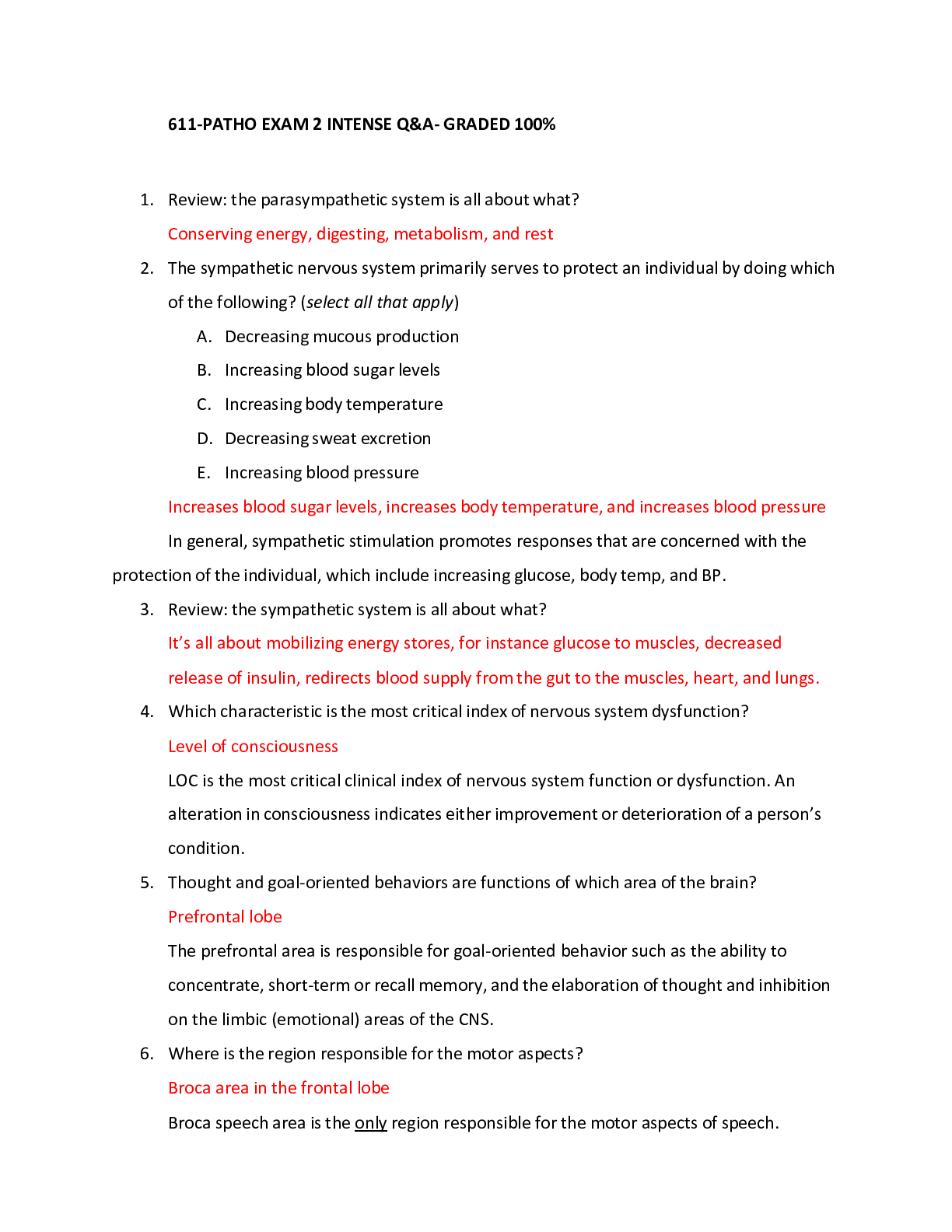
Reviews( 0 )
Document information
Connected school, study & course
About the document
Uploaded On
Apr 14, 2021
Number of pages
27
Written in
Additional information
This document has been written for:
Uploaded
Apr 14, 2021
Downloads
0
Views
36

 HESI VI EXIT EXAM.png)
